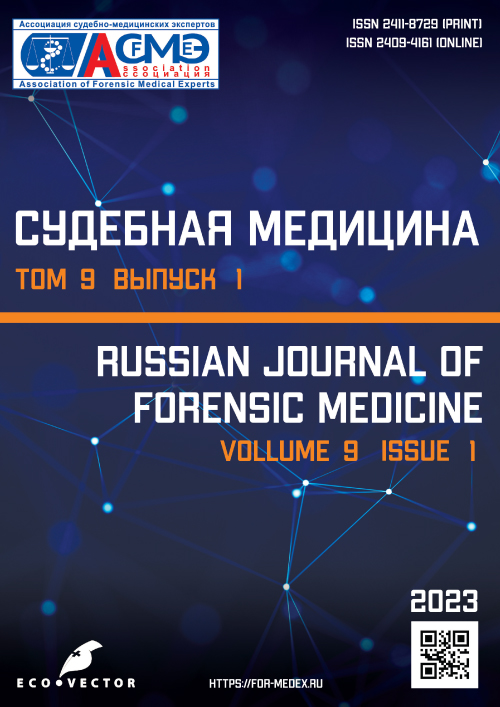卷 9, 编号 1 (2023)
- 年: 2023
- ##submission.datePublished##: 06.03.2023
- 文章: 11
- URL: https://for-medex.ru/jour/issue/view/37
- DOI: https://doi.org/10.17816/2411-8729-2023-9-1
完整期次
原创研究
手骨头闭合性骨折的法医学鉴定
摘要
论证。因为需要确定这些损伤的性质,发生机制,严重程度和长期,所以手骨闭合性骨折的法医方面的研究是特别令人感兴趣的。
研究目的是通过研究手骨头闭合性骨折的形成、过程和结果来评估损伤的严重程度。
材料和方法。研究了在受害者收了钝器创伤的情况下的腕骨头(n=24)和掌骨(n=218)的骨折。
结果。确定了,在腕结构中更常见的是手舟骨的骨折(81,8%),其他腕骨头的骨折是比较少见的(18,2%)。发生手舟骨的闭合性骨折时,尤其是在晚期就医的情况下,会出现假关节和无菌性坏死的并发症,同时桡腕关节的功能障碍是特别显著的。在掌骨中最常见的是掌骨近端骨骺的关节周围骨折(49,1%)、关节内骨折(26,6%)、关节周围的骨骺骨折(20,6%)。在掌骨骨折的长期治疗期间,手指挛缩的并发症最常发生在关节内、粉碎性和横断性骨折。
结论。孤立的无并发症闭合性腕骨头的骨折被视为轻中度损伤。同时,舟状骨骨折,并发假关节和无菌性坏死,腕关节功能严重受损,甚至不能活动,在功能上是不利的,按照丧失一般劳动能力的标准,可以定为严重的身体伤害。并发性和无并发性的腕骨头症闭合性骨折的严重程度被视为轻中度损伤。
 5-17
5-17


急性和慢性乙醇中毒时白鼠和人类睾丸的形态变化:一项实验和横断面研究
摘要
论证。特别令人感兴趣的是研究乙醇和麻醉物质对男性生殖系统的影响。几乎没有关于酒精中毒时睾丸形态变化的研究。由于目前的男性育龄人群的乙醇消费水平,这不但是一个医疗问题,也是一个社会问题,这个问题在最近的将来是无法解决的。
研究目的是在急性和慢性实验中研究乙醇中毒时性成熟白鼠睾丸形态变化的严重性和动态,并将其与因某种酒精性病而死亡的具有严重乙醇中毒的患者进行比较。
材料与方法。研究的材料是性成熟的白鼠的睾丸,其受急性和慢性酒精中毒(在2周至6个月的期间内),以及酒精中毒时的已故受试者的睾丸,血液中酒精含量至少为千分之五。
结果。在实验和断面材料中,睾丸基质的特点是明显的循环障碍,并发后毛细血管和小静脉的血流饱满和瘀滞、水肿、血管周围和间质硬化。断面材料中精子发生的抑制更明显,证明酒精是所发现变化的主要病因因素。
结论。慢性酒精中毒表现为直接损害因素,包括睾丸的基质和实质,也是损害生殖超级系统的高级部分(丘脑下部和脑下垂体)间接因素。毒害神经的、微血管病变和能量不足的 乙醇影响抑制正常的精子发生。最终,从形态学分析的角度来看,酒精的负面影响表现为睾丸功能减退的形式及睾丸衰竭综合征的形态学表现。
 19-27
19-27


根据莫斯科州的死亡医学证明,老年人死亡的主要原因
摘要
论证。世界上老年人口比例逐渐提高。为了开展医疗和社会的救助工作,要理解老年人的主要死亡原因。
研究目的是在死亡医学证明的基础上确定和讨论老年人的主要死亡原因。
材料和方法。从莫斯科州民事登记处总管理局的电子数据库(统一出生死亡结婚登记国家登记簿的系统)中挑选所以疾病列为根本死因的案例(排除了任何关于外源性死亡、损伤和中毒的编码),一共有109126个案例,其中90269个(82.7%)是60岁及以上的老人。组织了18组根本死因(95,2%是病死的);40442个(44,8%)医疗证明是法医鉴定中心签发的;一共在医院、家里和其他地方死亡的人数分别为50%,35.7%和14.3%。
结果。确定了5个主要死亡原因组:COVID-19(24,2%);与认识障碍和失智症有关的病理(21,15%;在60-69岁的人中为6.02%,是最低的;在100岁及以上的人中为63.5%,是最高的);慢性心脏缺血(18,6%);恶性肿瘤(10,7%;在60-69岁的人中为16.7%,是最高的;在100岁及以上的人中为1.46%,是最低的);急性脑血管意外病变(6,2%)。与60-74岁的人相比,在老年中以一些死亡原因是比较少见的:急性冠心病、急性脑出血、动脉高血压、糖尿病、COVID-19等。只医疗证明的30%包括填好的第二部分,填写的可能性受年龄、死亡地点、出具证明的地点(在法医鉴定中心出具的比在其他医疗机构出具的更少)和根本死因的影响。随着年龄的增长,法医鉴定中心法医局签发的医学死亡证明的比例提高。填写这种文件时经常使用没有临床诊断对应的编码。
结论。一些原因(原因组)的比例随着年龄会变更。为了更好地了解主要死因,必须在疾病和有关健康问题国际统计分类(第10版)代码部分的标准确定和应用理由的方面达成多学科共识。
 29-40
29-40


糖尿病昏迷在糖尿病病人的死亡率结构
摘要
论证。由于国内大多数地区在尸检阶段中的诊断不足,关于糖尿病病人的死亡原因信息不符合现实。
研究目的是在2017-2020年内由于糖尿病昏迷导致的糖尿病患者死亡率的统计分析。
材料与方法。进行了血液检测和玻璃体的生物化学分析。测定血液中的糖化血红蛋白以确认是否存在糖尿病。测定玻璃体中的葡萄糖、乳酸盐和丁铜酸酯的含量。我们之前已制定了通过玻璃体的生化分析对糖尿病昏迷进行鉴别诊断的标准。
结果。这项研究是在4444名猝然去世的糖尿病患者的尸体上进行的(这些患者在生前被登记为糖尿病病人)所有糖尿病患者的糖化血红蛋白水平都提高了。在分析糖尿病患者的死亡率结构时,发现了692个人的死因是糖尿病昏迷,占15.6%。在糖尿病患者的死亡率结构中,糖尿病昏迷的比例比统计数据中注明的的要高得多。这种情况是由于在死后诊断阶段中采用的实验室检查不足,以及糖尿病患者由于糖尿病昏迷导致的死因编码有限。制定的糖尿病昏迷诊断方式是易于执行的,确保结果的很高的准确性和可靠性,任何专业实验室都可以进行。
结论。最常见的是昏迷前状态(高渗性非酮症酸中毒昏迷的发作),其与昏迷结合在一起,使糖尿病昏迷的死亡率百分比最高。近年来,糖尿病昏迷导致的死亡率有下降的趋势。
 41-48
41-48


科学评论
Features of damage to the ribs by a blade with a defective tip
摘要
在法医专家实践中切刺伤是最常见的损伤。而且这种损伤更有可能发生在家里,例如, 在厨房争吵时,因为在手头一直会有一个刀子。值得注意的是,受影响的是有劳动能力的年经人,所以这个问题是社会意义的。
长期使用后菜刀会有使用的缺陷。比如说,多次磨尖后剑刃尖端变圆,使用过程中会变弯或折断。但研究这种剑刃这样的刀片对扁骨的影响之前,先要研究该问题的历史,查看其它专家的文章。
我们在研究科学文献过程中发现了,作者在调查切刺伤时更注重皮肤和衣服的伤害。直到21世纪,对骨骼损伤的形态特征和对其进行鉴定研究的可能性都被描述得较差。
为了改善用缺陷的剑刃造成的肋骨损害的法医诊断,必须在研究形态特征的基础上对尸体材料进行实验研究。
 49-56
49-56


临床病例报告
海绵窦血栓在法医实践中作为死亡原因
摘要
海绵窦血栓是一种危险的危及生命的状态,原因是血块堵塞海绵窦。这种病毒是很少见的,但是在任何年龄都对生命有很大的危险。在专门的法医文献中由于海绵窦血栓死亡的 信息是很少见和片断的。
在本文章中描述了35岁女尸的法医鉴定结果。在文章中叙述了所有对病人进行的医疗和观察的阶段。分阶段地描述了最终导致死亡的病毒发展。
基于进行的研究并考虑到文献的研究可以推断出死亡原因。海绵窦血栓和其他大脑的静脉窦血栓,是没有及时诊断和医疗的基础疾病的并发症,甚至在现代的多科性医院中也是一个重要问题,在临床实践中往往是死因。
 57-68
57-68


用利多卡因稀释的头孢曲松的肌肉注射作为死因的问题(病例)
摘要
在临床和专家实践中,有利多卡因肌肉注射后的病理过程的案例,其形式是毒性反应和过敏性休克,但是关于儿童死亡率的信息不多并不齐全。所发现的形态特征被认为是非特异性的,这导致很难解释研究结果和确定死亡原因。
我们研究了用百分之二的利多卡因稀释的头孢曲松的肌肉注射作为2岁儿童死因的案例。引用了一具尸体的初步检查和委托检查的结果,包括重复病理组织学检查的数据。对用百分之二的利多卡因稀释的头孢曲松的肌肉注射作为死因(包括毒性作用(过量)或过敏性休克的发展)的专家结论的客观化来说,需要评估临床症状的顺序及其性质,考虑到给药的途径,进行完整的病理组织学和形态学的检查,以及进行强制性的法医化学检查来测定这些药物在内脏器官和血液中的浓度。
一系列病理形态研究的数据,包括过敏性休克靶器官的变化和明显的血液循环障碍,可以被认为是过敏反应的验证性形态学标志。
我们认为需要对研究问题进行深入研究,以及使现有信息系统化。
 69-78
69-78


用钉子造成的穿入伤
摘要
调查各种罪行、自杀和意外事故时,与人体在受到某种伤害的情况下维持重要功能的能力 有关的问题会具有决定意义。最复杂的问题是在受到大脑的严重伤害的情况下,是否能独立行动。正因为如此,实践专家和临床的观察积累具有很大的实际意义,这些观察描述了身体在各种器官的致命伤中进行积极的、有目的的动作能力。
在本文章中描述了将建筑固定构件(15厘米长的金属钉子)打入颅腔的对头部结构造成的损害形态学特征。沿着伤口道的解剖结构的形态变化特性具有典型特征:刺伤,损伤面积小,边缘相对平坦;颅骨穿孔性骨折,内壁有锥状增宽缺陷。沿着伤口道损害了大脑结构。刺伤不是穿透的。
只有对尸体的法医学鉴定和案件材料进行全面评估,才能确定一个人在发生致命性脑损伤的情况下是否能进行复杂独立动作。
 79-85
79-85


怀疑采取不当的毒物护理措施的法医学鉴定 (实践案例)
摘要
在乙二醇中毒的情况下怀疑采取不当的毒物护理措施时,对诊疗过程进行法医学评估,以实践观察为例来显示该评估的主要原则。强调了阻碍采取毒理护理措施及进行其法医学评估的因素。
阻碍采取毒理护理措施及进行其法医学评估的因素包括:缺乏关于口服给药的目睹者或病人的信息,以及只有通过化学毒理学测试才能可靠地确定体内存在乙二醇。只是具有关于乙二醇中毒的正确信息或充分根据的假设,才采取毒物护理措施,其中包括用乙醇的解毒药疗法。因为在口服乙二醇的中毒时血流动力学的指标一直不稳定,病人运输时发生并发症的 风险比病人留在有高科技设备和24小时监控的专科医院时发生的高得多。
如果在乙二醇中毒时一个的医疗不能改善或至少不能稳定病人的状况,这不一定意味着医疗救护不当(不准确)。在急性口服乙二醇中毒的情况下,适当的医疗救护也不能保证避免 死亡。
 87-93
87-93


历史文章
叶尼塞省法医学成立200周年纪念历史概要
摘要
根据皇帝相关的命令叶尼塞省成立于1822年7月,包括5个地区。克拉斯诺亚尔斯克被确定为行政中心。
在1913年7月7日由于修订叶尼塞省医疗卫生法行为,制定了一项法律,任命了县医生五职,履行法医和医疗警察的职责,而不允许妇女履行这些职责。
在该文章中描述了职业关系的氛围、关于保证物资和科学信息的供应的问题,注明了参与诉讼程序的具体法医代表人的姓名。值得注意的是,他们得到别人的尊重,以及具有公务员队伍的较高的资格。
叶尼塞省法医历史概要是根据在克拉斯诺雅尔斯克边疆区的国家档案室保留的文章进行的。档案允许进行鉴定的性质和完整性与对专家文件提出的现代要求相比。在文章中有原本的图片。
 95-106
95-106


书评
对《根据国际疾病分类标准ICD-10作出法医学和病理解剖学鉴定、选择和编码死因的规则》医生指导书 的评论,主编为V.A. Klevno教授和 O.V. Zairatiants教授
摘要
在本文章中分析了《根据国际疾病分类标准ICD-10作出法医学和病理解剖学鉴定、选择和编码死因的规则的评论》,主编为医学博士Vladimir Aleksandrovich Klevno教授和医学博士Oleg Vadimovich Zairatiants教授。
评论目的是对学术刊物里的信息做正确价,以及确定这些信息对科学和实践的价值。
作者指出,该版本是为我国医生根据国际疾病分类标准ICD-10作出法医学和病理解剖学鉴定、选择和编码死因,以及编制死亡医学证明以改善死亡率统计的国家指导书。作者侧重于作出法医学和病理解剖学鉴定、选择和编码死因、编制死亡证明的统一规则。该规则根据于2011年11月21日323-FZ号联邦法律《关于俄罗斯联邦公共卫生保护的基础》、国际疾病分类标准ICD-10以及俄罗斯卫生部的命令和方法建议、俄罗斯病理解剖学家协会和法医病理学家协会的临床建议和方法建议。
我们可以非常肯定地说,该指导书可以长期保持现实性和需求性,因为符合所有规范性要求,明显地简化医生的工作,甚至可以成为从业者的参考书。
 107-111
107-111












